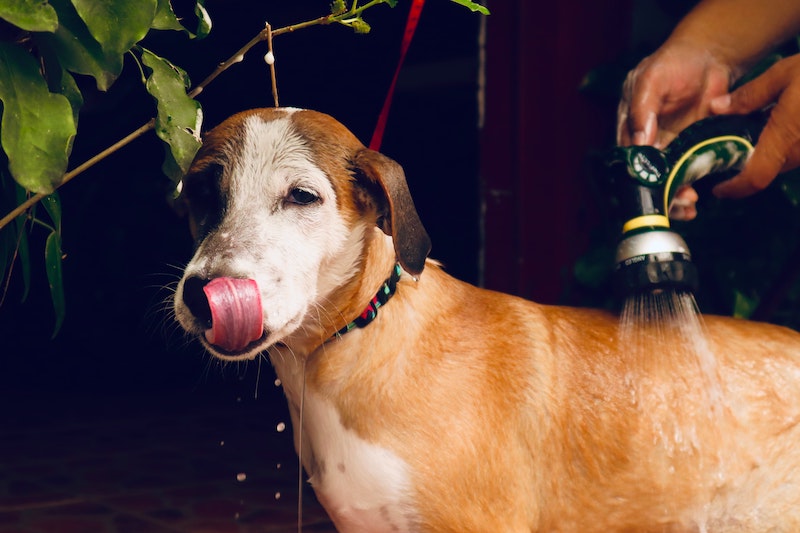The great outdoors are calling, and there’s no better hiking companion than your canine! But hiking with your pet requires a little extra preparation to keep them happy and healthy along the trail, and to respect the environment around you.
Let’s take a look at the best practices for hiking with your pup.
What does ‘Leave No Trace’ mean?
This concept encourages outdoor enthusiasts to enjoy time outdoors while minimizing their impact. The goal is essentially to preserve the integrity and beauty of nature by refraining from leaving any kind of waste or traces of human or pet activity.
When hiking with your dog, leaving no trace means following specific practices to keep nature pristine and beautiful—not just for the local wildlife, but also for other hikers who share the trails with you and your four-legged companion.
Before you hit the trail

Preparation is key to any hiking adventure, and when you’re bringing along your fur fam, there are some extra measures you should take to help set them up for success.
Consult with your vet
Schedule a visit with your vet to make sure your dog is physically fit for hiking. Ask about any vaccines or other preventative measures they might need, especially if you plan to hike in areas where ticks or other parasites are common.
Training and conditioning
Hiking is a strenuous activity for our four-legged friends. Create an exercise schedule to physically prepare them for the outdoor excursions. Gradually progress daily walks to longer sessions and more challenging terrains. Consistency is key to build up their stamina and adaptability.
If you plan for your pooch to wear a dog backpack to carry their own gear on the trail, include it in their training. First, get them used to wearing the pack, then gradually add weight to it. As a rule of thumb, a healthy dog can carry about 10-12% of their body weight.
These walks are also an important time to work on your pooch’s manners. Make sure your dog walks well on a leash and respects basic commands like—like sit, stay, and come.
Acclimate your dog to different environments, humans, and animals to help prevent excessive barking, becoming aggressive towards other animals or people, and other disruptive behaviors like digging.
Choose the right hike
It’s crucial to select a trail that is both dog-friendly and aligned with your dog’s physical abilities.
Look for hiking trails that allow dogs, and read up on leash regulations. For example, you can check out which National Parks allow dogs here, and search dog-friendly hikes in your area using websites like BringFido.
Consider a hike’s length, intensity, and the temperature outside to make sure it’s something your dog can handle (and enjoy).
It probably wouldn’t be a good idea to take your dog that’s used to a flat 1-mile loop on a high altitude 10-mile excursion with lots of scrambling up a mountain. Not only could it be dangerous for your dog, but it could also make for an even more difficult hike for you if you have to push or carry your dog over rough terrain.
Prepare their gear
Packing the right hiking gear is key to having a safe and fun outdoor adventure with your dog.
Here’s our recommended packing list of what to include in you or your pup’s pack:
- Water: At least one liter, more for longer hikes or hotter days
- Collapsible water bowl: For easy hydration on the go
- Dog food: Pre-measured for the length of the hike. For hikes that cross into mealtime or last multiple days, pack enough food for each day, plus an extra emergency meal.
- Treats: For training and rewarding good behavior
- Backup leash and collar
- Canine first-aid kit: Including bandages, antiseptics, pet-safe wipes, tweezers for tick removal, and any medications prescribed by your vet
- Pet-approved tick and flea repellent: Especially if you’re hiking in wooded or grassy areas
- Biodegradable poop bags
- ID tags: Make sure your dog’s tags are up-to-date with your contact information
- Lightweight, quick dry towel: For cleaning paws or quick drying after water crossings
- Chew toy or dog bone: For rest stops or to keep your dog occupied
During the hotter months, it’s even more important to take extra precautions to protect your pooch from the summer heat. As temperatures rise, look for signs of heat stroke and consider packing additional gear like:
- Doggy sunscreen
- Cooling mat and shade covering, if there won’t be a natural place to cool down on the trail
- Booties or paw wax
- Cooling bandana
- Dog hat
- Doggles
Best practices for hiking with dogs

Once you reach the trailhead, it’s important for both you and your four-legged hiking buddy to follow trail etiquette to respect the environment and other hikers.
For example, the National Park Service recommends that dog owners help their pup’s learn the B.A.R.K. principles, which include:
- Bag your pet’s waste
- Always leash your pet
- Respect wildlife
- Know where you can go
Stay on the trail
Stick to marked trails to minimize environmental damage. Letting your dog roam off-trail could also expose your dog to hidden dangers like poisonous plants or hidden holes.
If you’re hiking in the backcountry where pets are permitted, make sure to follow all posted regulations and guidelines for pet safety and environmental preservation.
Leash etiquette
It can be unpredictable how your pooch might react to wildlife, or an aggressive dog. Even if your dog is trained and well-behaved enough to go off-leash, respect leash laws by keeping your dog on a short leash, especially when passing other hikers or animals.
Pick up your dog’s poop
Always bring plenty of biodegradable poop bags to pick up after your dog, and carry out all of your dog’s waste until you reach a designated garbage or pet waste disposal bin.
Now, when it comes to your pup’s pee, encourage your dog to do their business at least 200 feet away from water sources, off the direct walking path, and somewhere with sparse vegetation.
Keep noises down
The trail isn’t just for humans and pets to enjoy, it’s home to a diversity of wildlife. Excessive barking can disturb local wildlife’s natural behaviors and add stress. It could even provoke attention from wild animals, potentially leading to a dangerous encounter.
Training your dog to respond to “quiet” commands, and offering them toys or treats to distract them from potential triggers, can help maintain harmony with your natural surroundings.
Leave what you find
That cool stick your dog found? As tempting as it may be, leave natural objects as you found them.
Taking sticks, stones, or other parts of nature from their home disrupts the local ecosystem and can affect both plant and animal life. Plus, these objects are part of the beauty of the trail, so they’re best left untouched for future trail goers to appreciate.
Training your pup to respond to commands like “leave it” and “drop it”, and diverting their attention with toys and treats can help keep nature as it was.
Safety tips around plants and other animals

You’ll likely encounter some flora and fauna along your journey. Let’s explore how to navigate the trail’s natural elements respectfully and safely.
Plants
Ingesting, or even touching, certain plants could lead to uncomfortable if not dangerous reactions in your dog. Follow these steps to help prevent any harm to your dog from plants:
- Before heading out, familiarize yourself with plants in the area that could be toxic to dogs, such as poison ivy, oak, and certain mushrooms.
- Keep your dog on a leash in dense vegetation, to prevent them from sniffing or ingesting harmful plants.
- Make sure your dog understands and obeys the “leave it” command to keep them from picking up or chewing on plants.
- Periodically check your dog’s mouth, paws, and fur to ensure they haven’t picked up any plant material.
If you notice your dog experiencing foaming at the mouth, vomiting or diarrhea, difficulty breathing, seizures, or skin irritation—seek treatment immediately.
Other dogs
Always ask for permission before letting your dog approach another hiker or their pet. Not all dogs are friendly or react well to strangers.
Wild animals
From squirrels and rabbits to bears and snakes, make sure you know what types of wildlife you might encounter on your hike. Keeping your dog on a leash is usually the best way to control unexpected situations.
Hiking in snake country? Learn more about what to do if your pooch is bitten by a snake, and consider snake training your dog.
Winding down after a hike

After a day of hiking, your pup deserves some recovery and TLC.
Here are some best practices:
- Hydrate: Your dog will likely be extra thirsty after a hike, so offer them plenty of fresh water. Be careful not to let them gulp it down too fast, which can lead to vomiting or other digestive issues.
- Nourish: A well-balanced meal will help in the recovery process, but avoid feeding immediately after the hike. Wait for your dog to calm down and cool off first.
- Groom and wash up: A good brushing removes additional dirt and burrs, helps you spot any ticks, and also gives you a chance to check for any unnoticed injuries. Depending on the trail conditions, a full bath may be needed to remove dirt, mud, and plant material. At the very least, wipe down your dog’s coat and paws before calling it a night.
- Check for ticks and fleas: Conduct a thorough body check for ticks, especially in hidden areas like the armpits, ears, and between the toes, and carefully remove them.
- Inspect paws: Carefully examine your dog’s paws for cuts, blisters, or foreign objects like thorns or small rocks. Remove any debris gently and clean any wounds.
- Rest: Give your dog time to rest and recover. They’ve used up a lot of energy, so make sure they have a comfortable place to lie down.
Keep an eye on your dog for any signs of excessive fatigue, discomfort, or changes in behavior after a hike. If anything seems off, a vet visit may be necessary.
Before we lace up our boots…
Even the most well-prepared pet parents and hikers can encounter an unexpected misadventure along the trail. That’s where pet insurance can be a lifesaver.
A base Lemonade Pet policy can help take a bite out of medical expenses for diagnostics and treatments related to accidents and illnesses (provided those occur after your policy’s waiting period has ended) including hike-related mishaps.
Plus, you can easily customize your pup’s policy with our preventative care packages and optional add-ons to meet the unique needs of your pup, and your wallet.
Click below to get your quote started. Happy trails!
A few quick words, because we <3 our lawyers: This post is general in nature, and any statement in it doesn’t alter the terms, conditions, exclusions, or limitations of policies issued by Lemonade, which differ according to your state of residence. You’re encouraged to discuss your specific circumstances with your own professional advisors. The purpose of this post is merely to provide you with info and insights you can use to make such discussions more productive! Naturally, all comments by, or references to, third parties represent their own views, and Lemonade assumes no responsibility for them. Coverage and discounts may not be available in all states.




